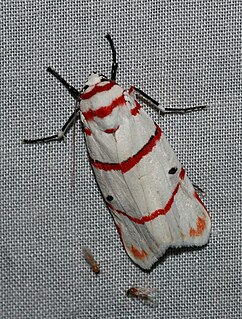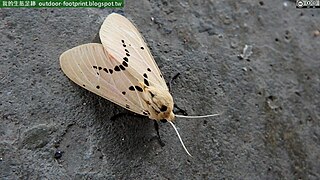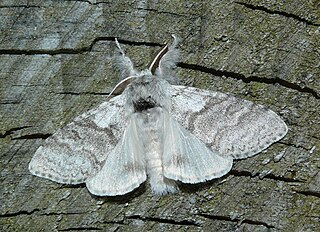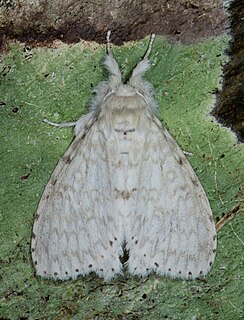
Ceryx is a genus of moths in the family Erebidae. It was described by Hans Daniel Johan Wallengren in 1863.

Cyana is a genus of moths in the family Erebidae. Species are well distributed in Africa, Madagascar, China, India, Sri Lanka, Myanmar, Sumatra, Java and Borneo. The genus was erected by Francis Walker in 1854.
Monosyntaxis is a genus of moths in the family Erebidae. The genus was erected by Swinhoe in 1901.

Scoliacma is a genus of tiger moths in the family Erebidae. The genus was erected by Edward Meyrick in 1886.

Spilarctia is a genus of moths in the family Erebidae. The genus was erected by Arthur Gardiner Butler in 1875.
Amphoraceras is a monotypic moth genus of the family Noctuidae. Its only species, Amphoraceras rothschildi, is found on New Guinea. Both the genus and the species were first described by George Thomas Bethune-Baker in 1904.
Hirsutopalpis is a monotypic moth genus of the family Erebidae. Its only species, Hirsutopalpis fasciata, is found in New Guinea. Both the genus and the species were first described by George Thomas Bethune-Baker in 1904.

Calliteara is a genus of tussock moths in the family Erebidae. The genus was erected by Arthur Gardiner Butler in 1881.

Dura is a genus of tussock moths in the family Erebidae. The genus was erected by Frederic Moore in 1879.

Euproctis is a genus of tussock moths in the family Erebidae described by Jacob Hübner in 1819. Species are cosmopolitan, widespread throughout Palearctic, African, Oriental and Australian regions. Molecular phylogenetic studies indicate that the genus as presently understood comprises a large number of unrelated lineages, only a few of which have names, and is therefore in serious need of revision.
Parakanchia is a genus of moths in the subfamily Lymantriinae. The genus was erected by George Thomas Bethune-Baker in 1908. The species are found in New Guinea.
Isostigena is a monotypic moth genus in the family Lasiocampidae erected by George Thomas Bethune-Baker in 1904. Its single species, Isostigena bicellata, described by the same author in the same year, was found in what is now Papua New Guinea.

Pararguda is a genus of moths in the family Lasiocampidae. The genus was erected by George Thomas Bethune-Baker in 1908. All the species identified in this genus were found in Australia.
Pseudophyllodes is a genus of moths in the family Lasiocampidae. The genus was erected by George Thomas Bethune-Baker in 1910.
Sporostigena is a genus of moths in the family Lasiocampidae. The genus was erected by George Thomas Bethune-Baker in 1904.
Pseudodreata is a genus of moths of the family Anthelidae. The genus was erected by George Thomas Bethune-Baker in 1904.

Phiala is a genus of moths in the family Eupterotidae.
Cotana is a genus of moths in the family Eupterotidae.
Melanergon is a monotypic moth genus in the family Eupterotidae described by George Thomas Bethune-Baker in 1904. Its only species, Melanergon vidua, was described by Francis Walker in 1865. It is found in New Guinea.
Lasioceros is a genus of moths in the family Erebidae. The genus was erected by George Thomas Bethune-Baker in 1904.








